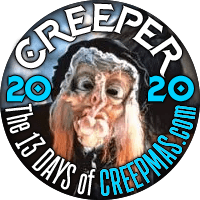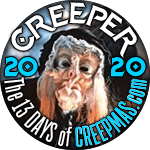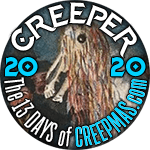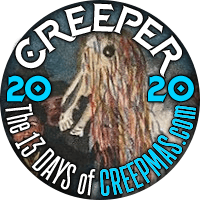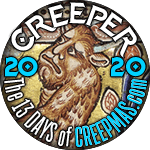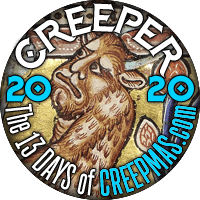THE 13 DAYS OF CREEPMAS 2020
To join the frightful festivities, leave a comment below (or email Chad) with your blog/website name and link, add one of the badges below to your blog/site, then post your creepiest Christmas content December 1-13!
Don't have a blog or website?
Join in on social media by tagging posts #Creepmas or #MakingCreepmas (see below)!2020 CREEPER BADGES
2020 #MakingCreepmas Image Challenge
Inspired by the Drawlloween & InkTober drawing challenges, the #MakingCreepmas image challenge invites anybody and everybody to make the holidays a little creepier by taking Christmas icons and putting a spooky spin on them.Think back to what Jack & Co. did to Christmas in "The Nightmare Before Christmas" and, more recently, what Michael Dougherty's "Krampus" did to Christmas toys - that's the challenge, in a nutshell! We want to see evil elves, terrifying toys and spooky Santas!
Draw it, paint it, photograph it, sculpt it, photomanipulate it - however you want to do it, each day of the 13 Days of Creepmas (December 1-13) has a different theme. Post your images on your social media accounts with the hashtag #MakingCreepmas and spread the word using this page's link and the image below - this year, Christmas will be ours!
Questions? Post them in the comments on THIS PAGE.
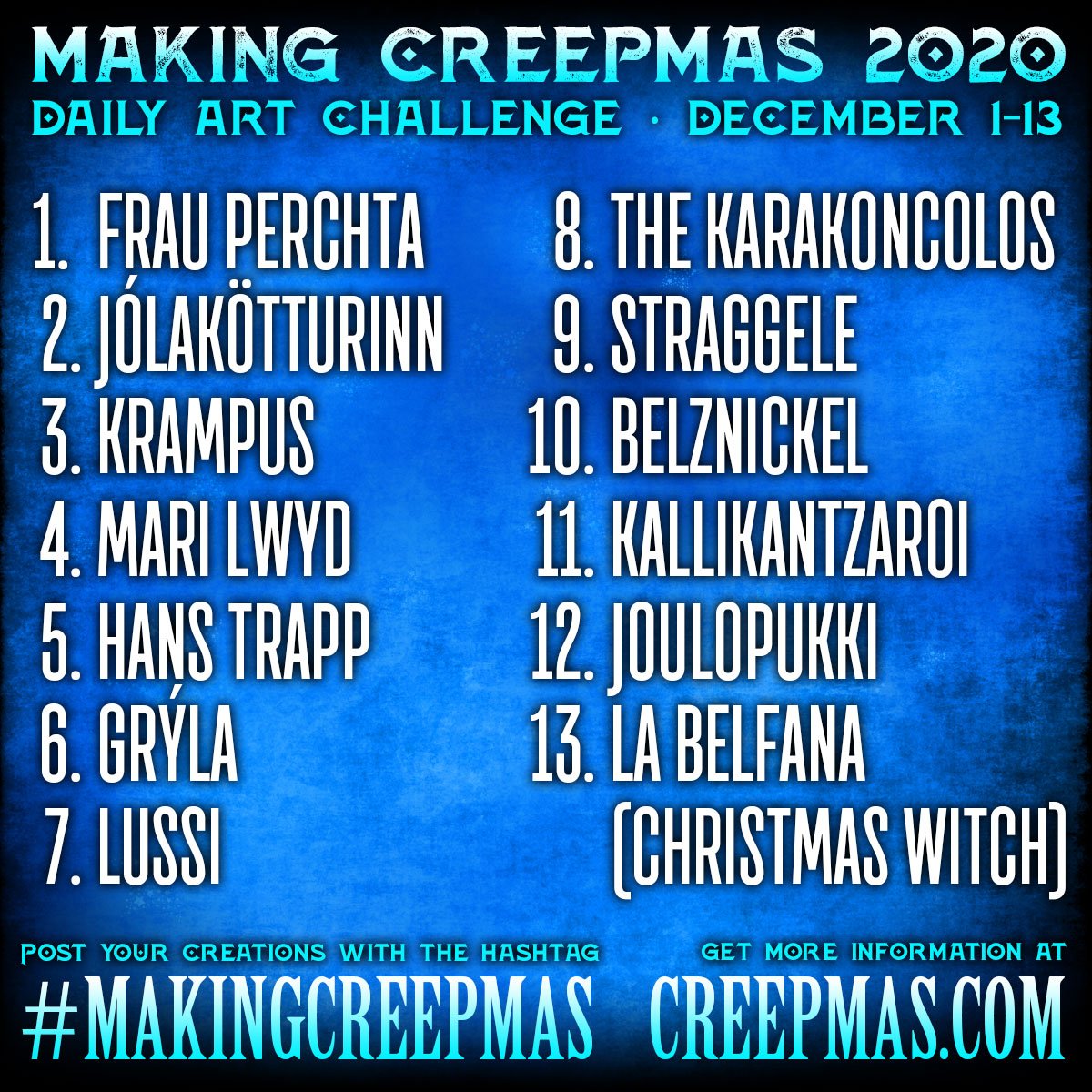
We're doing things a bit differently this year by focusing on the Christmas creatures and holiday horrors of cultures from around the world. To help get you started, each prompt has a little info below, but you are strongly encouraged to do further research (Google 'em!), as the following information just scratches the surface, and there are many, many interpretations of each of these characters!
1. Frau Perchta (Austria and parts of Germany and Italy)
In pre-Christian traditions, Perchta was an Alpine Goddess whose particular celebration day coincided with the Twelfth Night. After pre-Christian religions were displaced, she instead became a demonic witch who stalked villages, punishing anyone who dared to displease her.
Sometimes she appeared as a mischievous, dishevelled old woman. Alternatively, her appearance could depend on how you perceived her and whether you had pleased her.
If you were faithful, obedient and observed her rituals, Perchta would appear to you as a woman of divine beauty. If you angered her she would appear as a demonic, horned monster with a ferocious bloodlust.
Perchta would let you be as long as you followed her rituals on Perchta’s night, such as eating a traditional meal and special cakes baked in her honour.
Should you fail to do that, she would sneak into your room whilst you slept, slit your belly open and replace your innards with pebbles and straw. The following day, whoever discovered your corpse would assume you had simply died in your sleep.
2. Jólakötturinn or The Christmas Cat (Iceland)
Jólakötturinn is the Icelandic Yule Cat or Christmas Cat. He is not a nice cat; in fact, he might eat you. This character is tied to an Icelandic tradition in which those who finished all their work on time received new clothes for Christmas, while those who were lazy did not (although this was mainly a threat). To encourage children to work hard, parents told the tale of the Yule Cat, saying that Jólakötturinn could tell who the lazy children were because they did not have at least one new item of clothing for Christmas—and these children would be sacrificed to the Yule Cat. This reminder tends to spur children into doing their chores. A poem written about the cat ends with a suggestion that children help out the needy, so they, too, can have the protection of new clothing. It's no wonder that Icelanders put in more overtime at work than most Europeans.
Source: https://www.mentalfloss.com/article/54184/8-legendary-monsters-christmas
3. Krampus (Austria & Central Europe)
The word Krampus means "claw," and certain Alpine villages have big parties featuring a scary clawed incubus who hangs around with Santa Claus. The Krampus costume also includes sheepskin, horns, and a switch that the incubus uses to swat children and unsuspecting young ladies. The Krampus' job is to punish those who have been bad, while Santa rewards the people on his "nice" list.
Although the exact roots of Krampus aren't known, anthropologists generally agree that the legend probably derives from some sort of early horned god, who was then assimilated into the Christian devil figure. During the fifteenth and sixteenth centuries, masked devils began appearing in church plays during traditional winter celebrations. These events, which often had some fairly comedic and ludicrous elements to them, became part of the pre-Christmas fun that takes place each year.
Source: https://www.liveabout.com/creepy-christmas-monsters-4154307
4. Mari Lwyd (Wales)
In some parts of Wales, the custom of the Mari Lwyd is first documented around 1800, but may be far older than that. Much like the Beltane hobbyhorse, the Mari Lwyd originally consisted of a horse’s skull mounted on a stick and decorated with ribbons. In later years, the skull was made of wood or heavy paperboard. Although scholars differ on the origins of the tradition, one consistent feature is that the Mari Lwyd is associated with the practice of wassailing.
Between Christmas and New Years’, the Mari Lwyd is carried through the village by a group of men who knock on doors, singing and making merry. When the inhabitants answer, they are invited to engage in a battle of wits called a pwnco, exchanging rhyming insults – it’s a bit like a Welsh rap battle. At the end, the Mari Lwyd and her carriers are invited inside for refreshments, and her presence in your house is said to bring you good luck for the coming year.
Source: https://www.liveabout.com/creepy-christmas-monsters-4154307
5. Hans Trapp (France)
Hans Trapp is another "anti-Santa" who hands out punishment to bad children in the Alsace and Lorraine regions of France. The legend says that Trapp was a real man, a rich, greedy, and evil man, who worshiped Satan and was excommunicated from the Catholic Church. He was exiled into the forest where he preyed upon children, disguised as a scarecrow with straw jutting out from his clothing. He was about to eat one boy he captured when he was struck by lightning and killed—a punishment of his own from God. Still, he visits young children before Christmas, dressed as a scarecrow, to scare them into good behavior.
Source: https://www.mentalfloss.com/article/54184/8-legendary-monsters-christmas
6. Grýla (Iceland)
This giantess who lives in the mountains comes out of her cave in the wintertime, searching for naughty kids. When she finds them, she boils them up in a stew and devours them as a tasty snack.
Grýla is the mother of the thirteen Yule Lads, who visit sleeping children on the thirteen nights before Christmas. In some legends, the Lads, who have creepy names like Meat Hook and Window Peeper, are just as awful as their mother, and eat children too.
Grýla appears for the first time in Snorri Sturleson’s Prose Edda, but she didn’t become associated with the Christmas season until around the 17th century. By that time, kids were so terrified by the idea of Grýla that the Icelandic government had to step in and ban the use of her legend as a parenting technique. Instead, she was rebranded and presented in a way that has her spreading holiday cheer. As to the Yule Lads, now they just leave a rotten potato if you’ve been misbehaving.
Source: https://www.liveabout.com/creepy-christmas-monsters-4154307
7. Lussi (Norway)
In Norway and Sweden, 13 December is St Lucia’s Day. St Lucia is represented as a beautiful young woman and nowadays the occasion is marked by a a young woman in a white sash representing the Saint roaming the streets with a Health and Safety Officer-baiting crown of candles on her head.
However, a few centuries ago Norway celebrated Lucia (or Lussi) in a very different form. For the night before 13 December – Lussi’s Night - was the night when evil spirits and demons rose up to wander the Earth. Children needed to be good and the adults warded off evil by protecting their homes with the sign of the cross.
Lussi was portrayed as a hideous demon with tyrannical powers. She rode through the skies on a broomstick accompanied by demons, evil spirits and trolls, spreading mayhem and chaos, destroying property, crops and livestock and kidnapping or killing anyone foolish enough to not be tucked up safely in bed.
8. The Karakoncolos (Bulgaria, Turkey and Serbia)
The Karakoncolos is generally portrayed as a cross between the Devil and a Sasquatch. In Turkey, he would stand at street corners on winter nights setting riddles for passers-by. If the traveller gave an answer that included the word ‘black’ they were free to go on their way. If not, he would strike them dead with a single blow.
He would stand at street corners on winter nights setting riddles for passers-by
Elsewhere the Karakoncolos’ favourite trick was to disguise their voice to pretend to be someone’s friend or relative and lure their intended victim out into the snow.
Sometimes the creature would set them in a trance and leave them to roam free but in Serbia, the Karakoncolos preferred to jump on the victim’s back and use them as a personal taxi service. The exhausted person was only released at dawn.
If you invited a Karakoncolos into your house, they would feel compelled to imitate their hosts’ behaviour. If you set fire to silk or thread, the Karakancolos would be tricked into setting fire to its own fur, and would run from the house screaming to find water.
9: Straggele (Switzerland)
In many places, such as Switzerland, Frau Perchta rides with a throng of demonic-looking helpers — known as Straggele — who love to partake of the feast offerings left out for them on Christmas by people hoping for Perchta’s blessings of wealth and health in the new year. In some places, Straggele get to dole out the punishments themselves and aren’t terribly discerning as they rob all bad children and tear them to pieces in the air.
Source: https://www.atlasobscura.com/articles/monsters-of-christmas
10. Belznickel (Germany)
A scary, darker Christmas visitor in the South West of Germany and amongst German speaking communities in the United States was Belznickel. Also known as Belschnickel, Belznickle, Belznickel, Pelznikel, Pelznickel, the name literally translates as "Walloping Nicky" i.e. he is a Nicholas that thumps! Because of this some say he is a version of St Nicholas, but he isn't exactly. Whilst Nicholas is the name of the saint, there are also examples of the name Nicholas being used for the devil...
Belznickel is crotchety, grumpy and very scary, particularly for children who have been bad. At his most fearsome he would appear at the door, dressed in tatty furs with a long white beard, rattling chains and branches of birch against the window until let in. Once he entered the house he would enter the house and would be able to sense which children had been bad. Bad children would be hit with a switch (in some versions, sometimes it would just be a threat!) and made to perform a song or dance, and promise to be good. Belznickel would reward the children with gifts of candies, fruit and cookies.
Source: https://holidappy.com/holidays/Different-versions-of-Santa-Claus
11. Kallikantzaroi (Greece)
Kallikantzaroi are mischievous goblins, elves or gnomes that appear during the twelve days of Christmas, from the end of December until Epiphany, January sixth. They are pictured as hairy human-like beings, with goat or donkey legs, ape tail and a thin, long human face. It is believed that Kallikantzaroi stay underground sawing the World Tree so that it will collapse, along with Earth. However, when they are about to saw the final part, Christmas dawns and they are able to come to the surface. They forget the Tree and come to bring trouble to mortals. They come out of hiding at night to enter houses any way they can, through windows, down chimneys, through keyholes, and any cracks that they may find, in walls and around doors.
Once inside they cause havoc.
Sources: https://www.grethexis.com/kallikantzaroi-greek-evil-spirits-christmas/
https://fromtinypennies.com/2018/11/25/kallikantzaroi-christmas-goblins/
12. Joulopukki (Finland)
The Finnish equivalent for Father Christmas, Santa Claus, St. Nicholas etc, is joulupukki, who has his origin in the pagan Nordic shaman tradition of people dressing up in animal disguises (in this case, a goat).
Joulupukki was once a symbol of fertility and more of a frightening figure back then than today. He was clad in thick fur-lined coat turned inside out, wearing a mask and a pair of horns on his head. The name joulupukki literally means "Christmas goat".
This version of "Santa" is the subject of the excellent Finnish film "Rare Exports".
Source: http://www.dlc.fi/~marian1/gourmet/xmas_3.htm
13. La Befana, aka Christmas Witch (Italy/Russia/Eastern Europe)
La Befana gets around. She comes from Italy, Russia and Eastern Europe. In Russia they call her “Baboushka,” but her MO is the same no matter what she’s called. She’s also known as the Christmas Witch, and she’ll give both punishments and prizes. If you’re good, you’ll get cookies and gifts — but if you’re bad you’ll get coal. And if you stay up and catch a glimpse of her, she’ll whack you with the broom that she rides!

